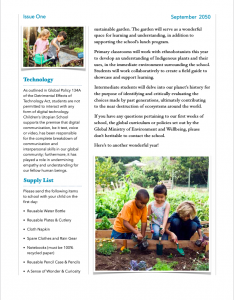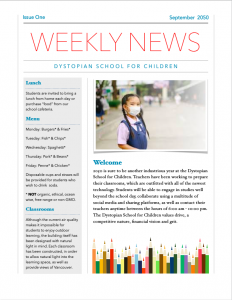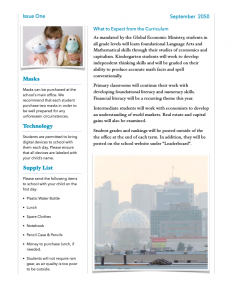Speculative Futures: Utopian versus Dystopian
In order to highlight two speculative futures, I thought it might be interesting to create two school newsletters welcoming students back in September. Both newsletters take on the same format; however, the first has been created with a utopian lens and the second, using a dystopian perspective.
The Children’s Utopian School (which could be considered the protagonist…although there are some antagonistic undertones) believes that conservation needs to be at the core of everything children learn and do. It is anti-animal agriculture, pro-plant-based, opposed to digital technology and in support of everything reusable and recycled. It abides by all policies imposed by the Global Ministry of Environment and Wellbeing, and takes pride in announcing its allegiance in the newsletter.
Children’s Utopian School – Weekly News: Issue One (Format: Digital)


Dystopian School for Children – Weekly News: Issue One (Format: Paper)
The Dystopian School for Children (likely the antagonist of the two), chooses commerce, capitalism and individual success over environment and the collective good. Greed breeds here and children are recognized for excelling over all else. Outdoor play is impossible due to the actions of previous generations, and rather than learning from the past, it’s full steam ahead. If you’re taking an admissions tour, bring your mask and don’t expect to enjoy the views from the classroom windows.


Inspiration & Reflection
The approach for this assignment grew out of my readings around Utopian and Dystopian Speculative Fiction, which was initially prompted by the assignment’s link to the Speculative Narratives Wikipedia Page! I wanted to create some kind of artifact which would hint at these perspectives, while still relating to my own experiences and knowledge. The format of a newsletter is one I’m deeply familiar with (I’ve certainly created a Kindergarten Newsletter or two over the past 17 years), and the opportunity to create something completely fictional was quite appealing. Although significantly less succinct than Banksy’s art, I think the newsletters prompt thinking and discourse around environmental, social, economical, technological and political issues, both present and future.
